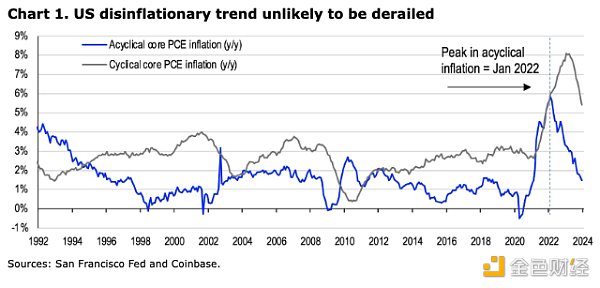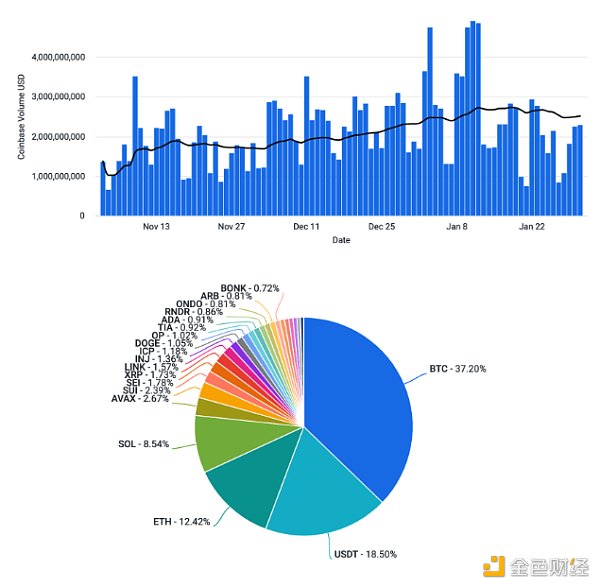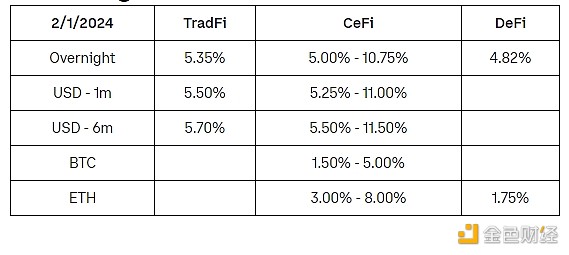Source: Coinbase; Compiled by: Deng Tong, Golden Finance
Abstract
We believe that many of the technical factors driving the downside performance of cryptocurrencies have begun to exhaust themselves, which may give way to a more supportive trading environment in the coming weeks.
We expect U.S. interest rate cuts to begin in May and to gradually taper quantitative tightening shortly thereafter, coinciding with special events such as the Bitcoin halving and setting the stage for broader Asset classes create a positive environment.
Solana airdrop season continues in earnest, with Jupiter, Solana’s leading decentralized exchange aggregator, launching the first of four airdrops on January 31st.
Market Views
Stronger Macro Background
We believe that many of the concerns about Bitcoin (and cryptocurrencies more broadly) ) The technical factors exerting pressure have begun to run out. This is evidenced by the liquidation of FTX (such as the disposal of its Grayscale Bitcoin Trust or GBTC shares) and the emergence of several large entities that went bankrupt. In fact, net inflows into U.S. spot Bitcoin ETFs averaged over $200 million per day last week (totaling net inflows since January 11 to $1.46 billion), with daily trading volume of approximately $1.35 billion. Therefore,we expect macro factors to become more relevant to the digital asset class in the coming weeks, which may support market conditions.
In the United States, the likelihood of a soft landing appears higher than a few months ago, as the economy appears to be trading off only minimal trade-offs between economic activity and inflation. Core PCE inflation, the Fed's preferred measure of prices, rose 2.7% year-over-year, in line with the 2% longer-run target, and a variety of recent economic indicators have also been quite resilient. We have previously explained that part of this mix has to do with pro-cyclical government spending and still-strong levels of personal consumption, although we do not believe these drivers will persist in the coming months.
Not only is the U.S. budget deficit expanding, but the labor market is also cooling. The U.S. personal savings rate fell to 17.6% from the previous year (December 2023), suggesting that many U.S. households are saving less. That's despite an unexpected rise in retail sales over the past six months relative to the median survey forecast. Ultimately, we expect the economy to likely slow in the first half of 2024, although the odds of avoiding an outright recession appear very high—although the situation at New York Community Banks (NYCB) and the impact on regional banks is concerning.
This week, we have some indications of how the Fed is interpreting the situation. The FOMC meeting statement said "risks to achieving [the committee's] employment and inflation goals are becoming better balanced," but the committee argued they lacked the needed confidence in inflation trends ahead of the meeting. March meeting. Discussions on tapering the quantitative tightening (QT) program were postponed to the next meeting on March 19-20.
Overall, this suggests that the easing cycle will likely begin on May 1, and that the Fed's balance sheet reduction program may begin to end in June (although it is possible that it will begin around the same time as the rate cut) . We don't think the deflationary trend is derailed and expect the Fed to cut rates by 100 basis points this year, compared with the 75 basis points implied in the dot plot or nearly 150 basis points priced in federal funds futures. It's also consistent with the dovish stance policymakers typically take in election years.
Ultimately, this will coincide with special drivers such as the Bitcoin halving at the end of April and possibly in 2024 The second quarter supported Bitcoin and other coins. Additionally, we expect greater advertising by ETF issuers and the inclusion of spot Bitcoin ETFs in asset managers’ model portfolios to unlock liquidity in the space.

On-Chain: Solana Airdrop Season
Solana’s airdrop to Jupiter, the leading decentralized exchange aggregator, took place on January 31st and was one of the largest airdrops ever. This is a continuation of the renewed focus on the ecosystem in the second half of 2023, with token launches from major long-term Solana ecosystem protocols such as Pyth in November 2023 and Jito in December.
This trend is expected to continue for at least a few months, as many other high-profile Solana projects still do not have tokens, and three additional Jupiter airdrops of similar size have yet to be released. We believe that the issuance of these tokens will form the basis of the new Solana ecosystem, coupled with the increasing pace of stablecoin inflows into Solana (up 13.7% over the past week to $2.19 billion), may make the ecosystem increasingly attractive to developers who may have previously been concerned about on-chain liquidity.
We believe that an underappreciated but important outcome of this airdrop is that the airdrop represents a “real world” stress test of the Solana blockchain. Although individual nodes were overloaded, resulting in multiple instances of poor user experience and transaction timeouts, the blockchain did not experience widespread outages.
Solana is about to mark its first full year without any outages (the most recent outage was on February 25, 2023), demonstrating significant progress in its ecosystem - especially with This compares with the history of earlier crashes that disrupted chains for days at a time. Solana recently released the 1.17 mainnet version for validators on January 15, which also promptly improved the overall performance and stability of the node. It was also recently announced that Solana Labs is spinning off into a new legal entity, Anza Technologies, which may further increase diversification and enhance the network's resiliency.
Having said that, the boosted airdrop campaign did reveal some limitations in Solana’s performance. There are known reporting gaps for clear indicators of transaction failures due to overloaded nodes, as such transactions are neither recorded on-chain nor stored long-term in mempools like Ethereum. Ultimately, it makes little difference to end users, especially non-technical users, if transactions fail due to reversals of on-chain execution, leaks or delays in the node broadcast phase. The lack of data collection and tools around such infrastructure issues makes it more difficult to replicate, test, and resolve, which can lead to discrepancies between actual user experience and long-term purely on-chain transaction statistics.
Additionally, during the launch of the first airdrop, the average priority fee soared over 100x at times, from $0.001 to over $0.1. While this is significantly less than crowded Ethereum, it highlights the incompleteness of Solana’s pseudo-localized fee market and its priority fee mechanism, where high-fee transactions only have probabilistic guarantees for block inclusion. Currently, the Solana Labs team is working on some changes to the fee mechanism, and we may see an initial fix for this in version 1.18 (as early as April), but the final resolution mechanism has not yet been determined. Nonetheless, the surge in fees and the temporary decline in on-chain user experience highlight the continued focus and importance of various scalability approaches in this space.
Overview of encryption and tradition

Coinbase Exchange and CES Insights
Traders are more constructive about the market. BTC found good support at the 100-day EMA and CME OI has stabilized. Additionally, ETF flows have remained solidly positive over the past week, with more than $600 million entering the product and nearly $1.5 billion since launch. Taken together, these data points make market participants more willing to hold and increase their long-term cryptocurrency exposure. However, even with the overall positive sentiment, ETH still seems to be lacking interest. It has fallen from the second most traded asset on the exchange to the third most traded, and trades volume is only slightly higher than SOL.

Financing Interest Rate h3>

Notable Crypto News
Organization:
Regulation:
Comprehensive :
Coinbase:
< ul class=" list-paddingleft-2" style="list-style-type: disc;">
Bridge Status (Coinbase Blog);
Coinbase Advanced now offers fee upgrade plan for high-volume traders (Coinbase Blog)
News from around the world
Europe
The Bank of England and HM Treasury have published a response to last year’s consultation on a potential digital pound, determining that further research is needed before a final decision is made on whether a CBDC is necessary for the UK, but that their exploratory work on potential designs will continue. .
According to guidelines proposed by the European Securities and Markets Authority (ESMA), cryptocurrency companies based outside the EU will only be allowed to directly serve customers within the EU under limited conditions. , to promote fair competition under MiCA regulations.
German authorities have seized more than $2 billion worth of Bitcoin that two individuals allegedly obtained through unauthorized commercial use and distribution of copyrighted material. The largest cryptocurrency seizure ever made by law enforcement.
An Italian startup called BlockInvest plans to tokenize bad loans on the Polygon network through two new projects aimed at solving the multi-billion dollar bad credit market.
The Swiss Financial Market Supervisory Authority (FINMA) has approved digital asset market provider Taurus to open its platform to retail investors, allowing individuals to trade digital securities and tokens accepted by Taurus Digital Exchange (TDX) assets.
Asia
According to reports, Chinese asset management company Harvest Global Investments has applied for a spot Bitcoin ETF in Hong Kong , and discussed participating in Hong Kong’s planned stablecoin regulatory sandbox.
Two Japanese MPs want to develop the country’s web3 policy and have been holding discussions and hosting DAO hackathons to understand stakeholder needs.
The Securities and Exchange Commission of Thailand has updated its cryptocurrency regulations, removing retail investment restrictions on asset-backed tokens and establishing new rules for custodial wallets and digital business monitoring.
 JinseFinance
JinseFinance








